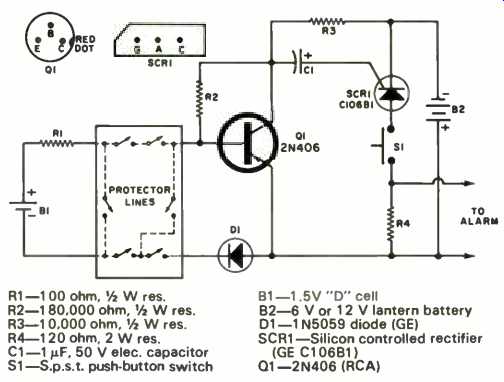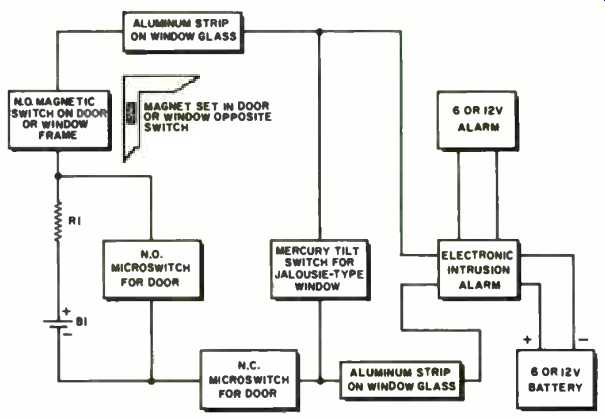
By GENE M. PRESSON
A solid-state alarm that will foil even a clever burglar by the use of two different types of detection circuits.
MOST electrical, or electronic, intrusion-alarm systems fall into one of two categories. The first type is activated when its detector circuit is broken; the second type is activated only when its detector circuit is shorted. Disarming one of these is relatively simple once a burglar determines which type of circuit is being used. Combining both detection methods into one system makes it impossible for the burglar to determine what bypass device he should use.
This alarm sounds off when its detector circuit is either shorted or broken. Hence, a window or door may be protected in more than one way by the same alarm system.
Some electronic burglar alarm systems use a relay which, after months of inactivity, can fail to function properly and sabotage the entire protection system. This particular intrusion-alarm circuit eliminates the relay and its possible failure.
Finally, the circuit is all solid-state. Thus the system draws such a small amount of current that a standard six-or twelve-volt lantern battery will power it for months. This also provides protection against power failures during storms or by removal of the a.c. power by a burglar.
How it Works
Operating the push-button switch S1 (Fig. 1) applies operating voltage to the silicon controlled rectifier SCR1. The 1.5-volt battery (81) however prevents current flow through the circuit by holding Q1 turned off. If the protector lines are short-circuited by the closing of any of the parallel normally open (n.o.) switches, Q1 is triggered into conduction by R2. At this time the silicon controlled rectifier SCR1 is triggered into conduction, causing the alarm to sound off.
If the protector lines are broken or if any of the series normally closed ( n.c.) switches are opened, Q1 and SCR1 are again triggered into conduction by the voltage through R2, sounding the alarm. R3 acts as a holding resistor when a conventional alarm bell is used.
The alarm, once activated, will continue to ring as long as the alarm battery holds out, or until the circuit is reset. To reset the alarm circuit it is necessary to push S1 twice--once to disconnect the alarm battery, and then once again to re-arm the circuit.
The author mounted all the components except S1 and R1 on a 1 1/2 x 3-in piece of perforated phenolic board. The circuit board may be glued inside a plastic box or mounted in a small metal box. Standard phono plugs make excellent connectors for the external parts of the circuit.
Installing the System
A convenient, concealed location (such as inside a cabinet, a closet, or under a stairway) should be selected for mounting the box and alarm battery. A hidden location on the outside of your house or in an attached garage may be used for mounting S1. With this arrangement you can arm the system before leaving home and disarm it before going into the house when you return.
A wide variety of switches can be used to trip the alarm circuit (Fig. 2). These do not have to be either expensive or complex.

Fig. 1. Protector lines shown dashed represent the various combination
of switches and conductive foil (sensing tape).

Fig. 2. Arrangement of switches and aluminum foil. Any number of switches
or conductive strips may be paralleled.
Each door and window in the house should be protected by at least two different types of switches. One of these should be designed to break one of the series protector lines, and the other switch should short-circuit the protector lines when the window or door is opened. The aluminum ribbon for window glass can be cut from regular kitchen aluminum foil and glued or taped in position. You may prefer to buy aluminum tape with adhesive applied. This tape is sold by most tape-recorder dealers.
You might want to mount the sounding system, which may be any 6- or 12-volt d.c. device, such as a bell, buzzer, or horn, somewhere on top of the roof. In this location it will alert your neighbors, or a nearby police car, and hopefully drive away a potential burglar who may see it.
======
======
(adapted from: Electronics World magazine; Jul. 1975)
================